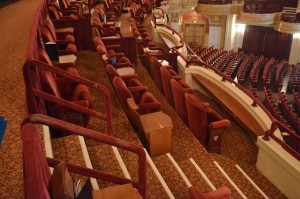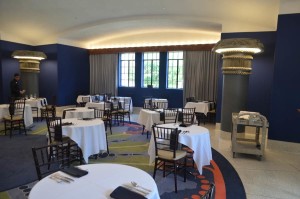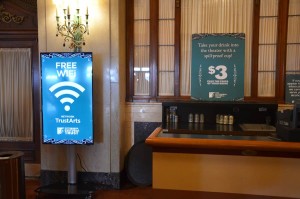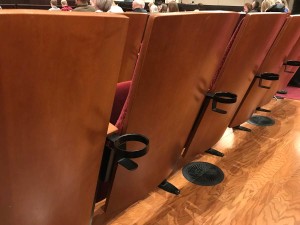Making a Night (or Day) of it: Food in the Performing Arts Center
By Jack P. Hagler, ASTC

Premium seating with table service at Palace Theatre, Playhouse Square, Cleveland, OH. (Photo by Paul Sanow, ASTC)
Food culture in the U.S. has evolved, in a good way, over the past two decades. The evolution has caught up to the performing arts, which are now placing a priority on the integration of high-quality food, drink, and dining experiences for audiences. This first manifested in the offering of premium wines, liquors and craft beers at Performing Arts Centers (PACs). The offerings continued to elevate with pre- and post-show dining, food, and drink experiences; wait service within the audience chamber; and an increase in catered private receptions and VIP events. A smattering of civic PACs have been including restaurants or cafés in their buildings for a while. Now this concept is moving into more civic PACs and even into university PAC design.
Patron expectations have been raised by the higher quality foods being offered at restaurants. The foodie movement is being supported in PACs with the inclusion of spaces specifically designed for these offerings: prep or full-service kitchens, coolers and freezers, serving-ware storage and cleaning equipment, and foodservice staff support areas. Some PACs have their food branded by star chefs and, in some cases, prepared by star chefs themselves. This level of quality enhances the patron experience and ups the patron expectation. PACs are keeping up.

Tobin Center in San Antonio, TX includes two Rotunda rooms for variety of seated events (Photo by Paul Sanow, ASTC)
One of the early adopters of this trend was Cobb Energy Performing Arts Center in Atlanta, a venue that hosts a variety of events, from Broadway to ballet, and offers a comprehensive menu of seasonal, contemporary cuisine. Its in-house, full-service kitchen provides the flexibility to customize menus for executive luncheons, corporate meetings, receptions, and other special events.
Adding food service opens the doors to new opportunities for daytime patronage as well. The design for Lubbock’s upcoming Buddy Holly Hall includes a bistro café adjacent to the rehearsal room block of the building. During the day, the center’s rehearsal space will be used for children’s dance classes making the bistro the perfect spot for parents to grab a bite while their children are in class or rehearsal.

The Benedum Center in Pittsburgh, PA offers spill-proof cups to prevent spills and generate more concession revenue. (Photo by Paul Sanow, ASTC)
The food-and-beverage trend impacts the audience chamber as well. Patrons expect to bring beverages, and sometimes food, into the audience chamber to enjoy during a performance. Theatre operators are increasingly happy to accommodate. Many theatre managers report as much as a quadruple increase in concession revenues by allowing drinks (in containers with tight-fitting “sippy” lids) into the audience chamber during a performance. When deciding to permit food or beverage into audience seating, cleaning costs must be considered. Most managers report the increase in concession income far exceeds chair cleaning and replacement costs. While some may decide food and beverage should be restricted to the lobby, the trend seems to favor increasing revenue by allowing audiences to indulge in their seats.
Many theatres do not have a means of accommodating beverage containers, so patrons must hold their cups through the entire performance or place the container on the floor. What better way to give patrons a convenient place to set those cups and keep them from rolling around making noise than some form of cup-holders for the seats? Cup holders in performing arts centers – they are here to stay!



